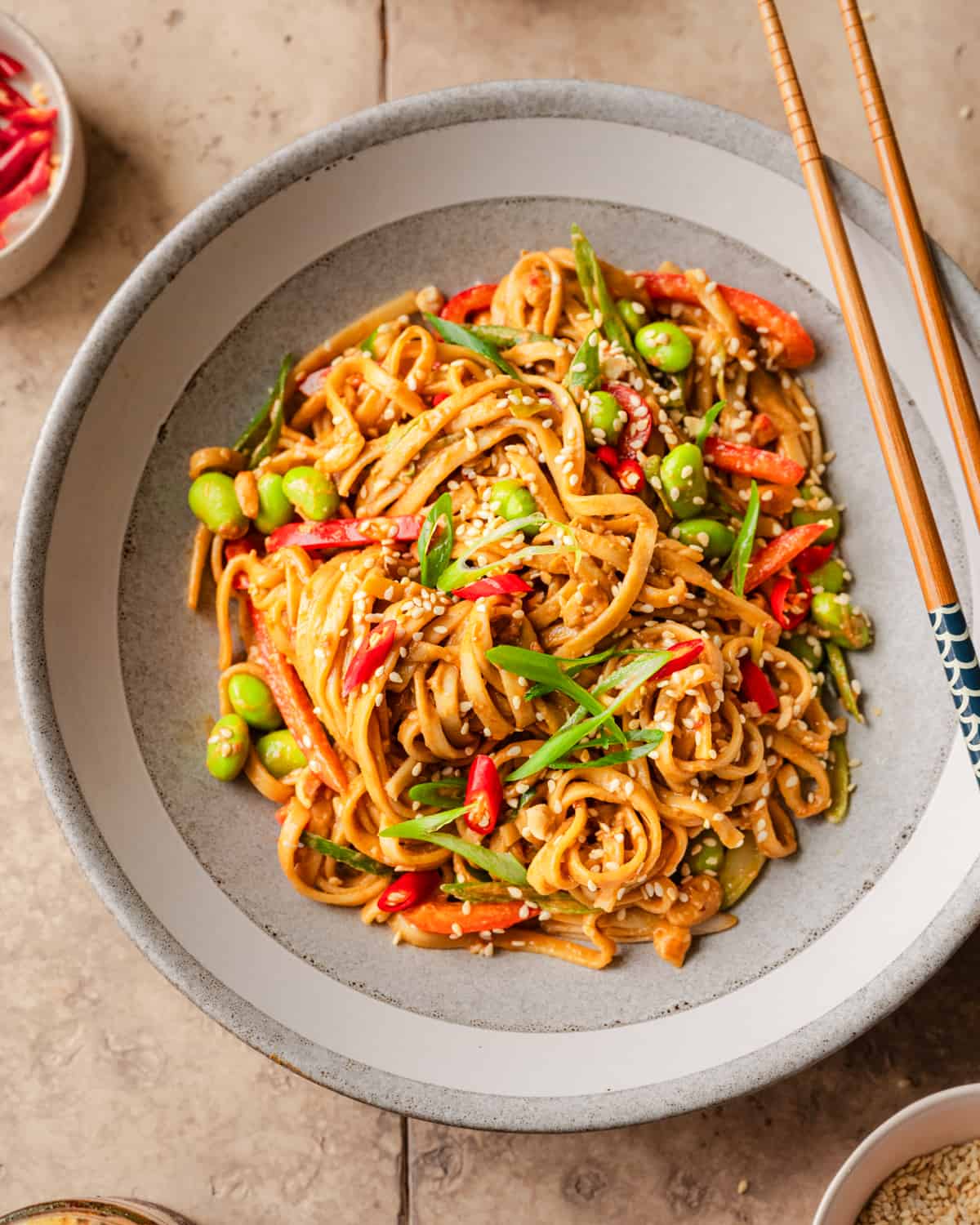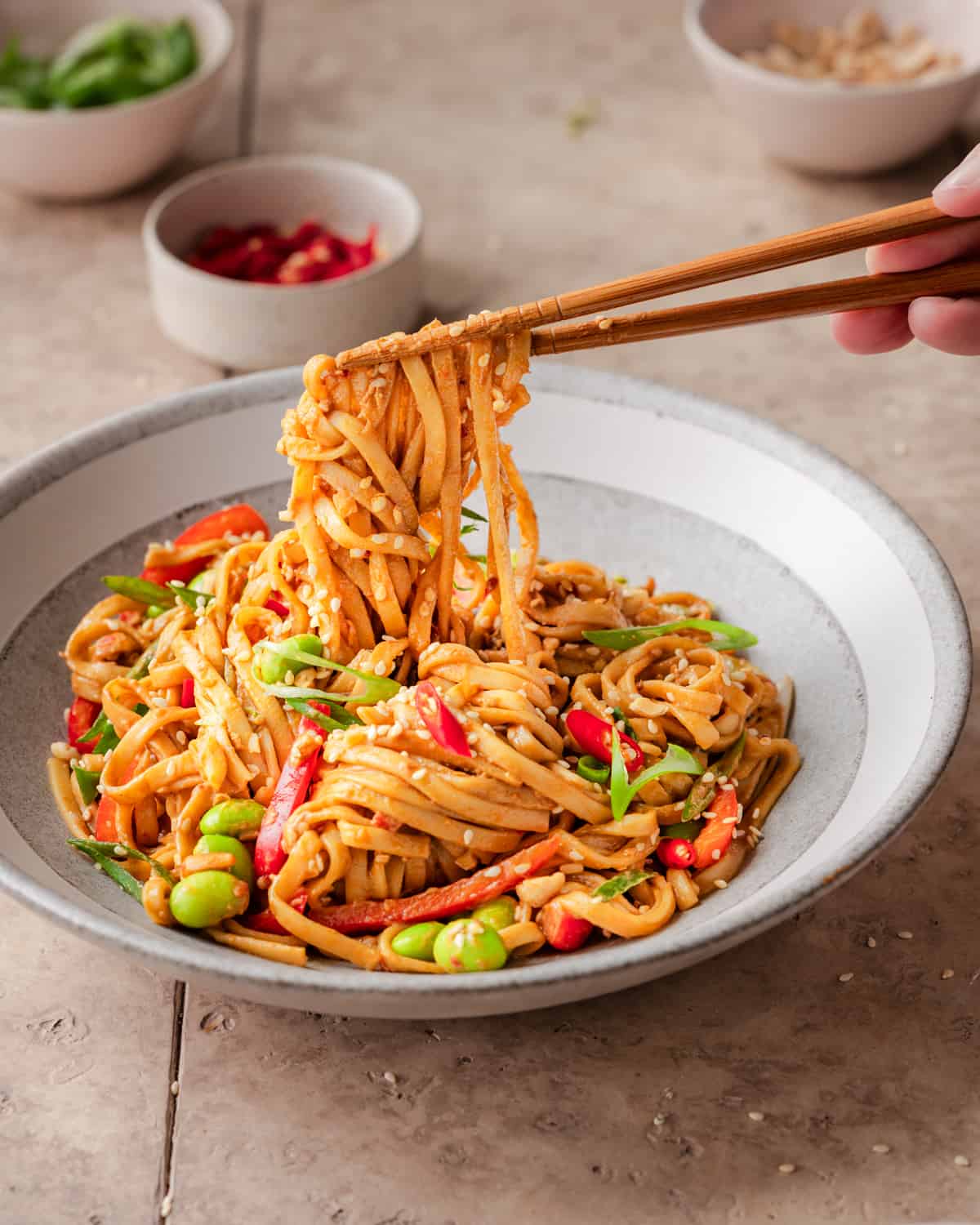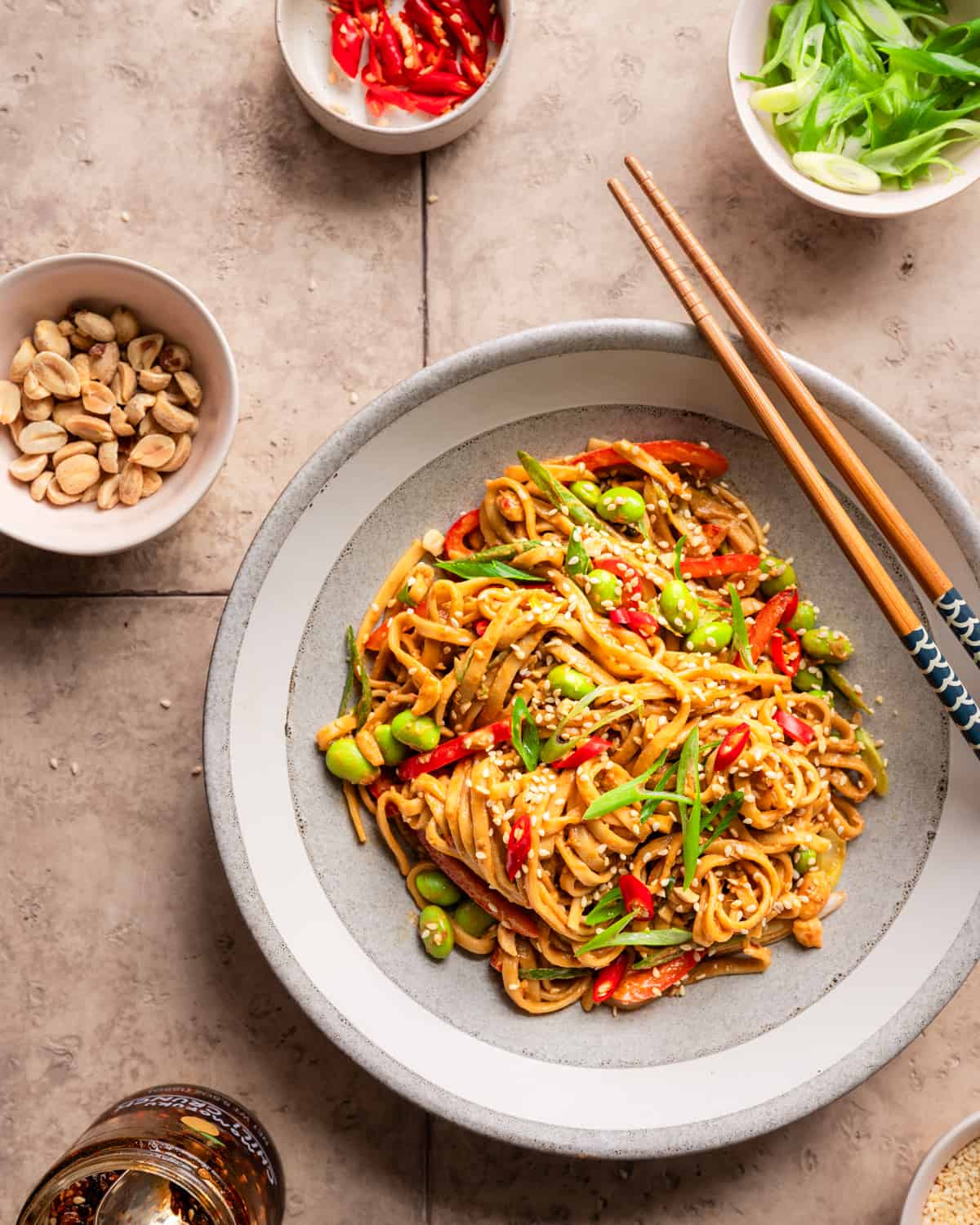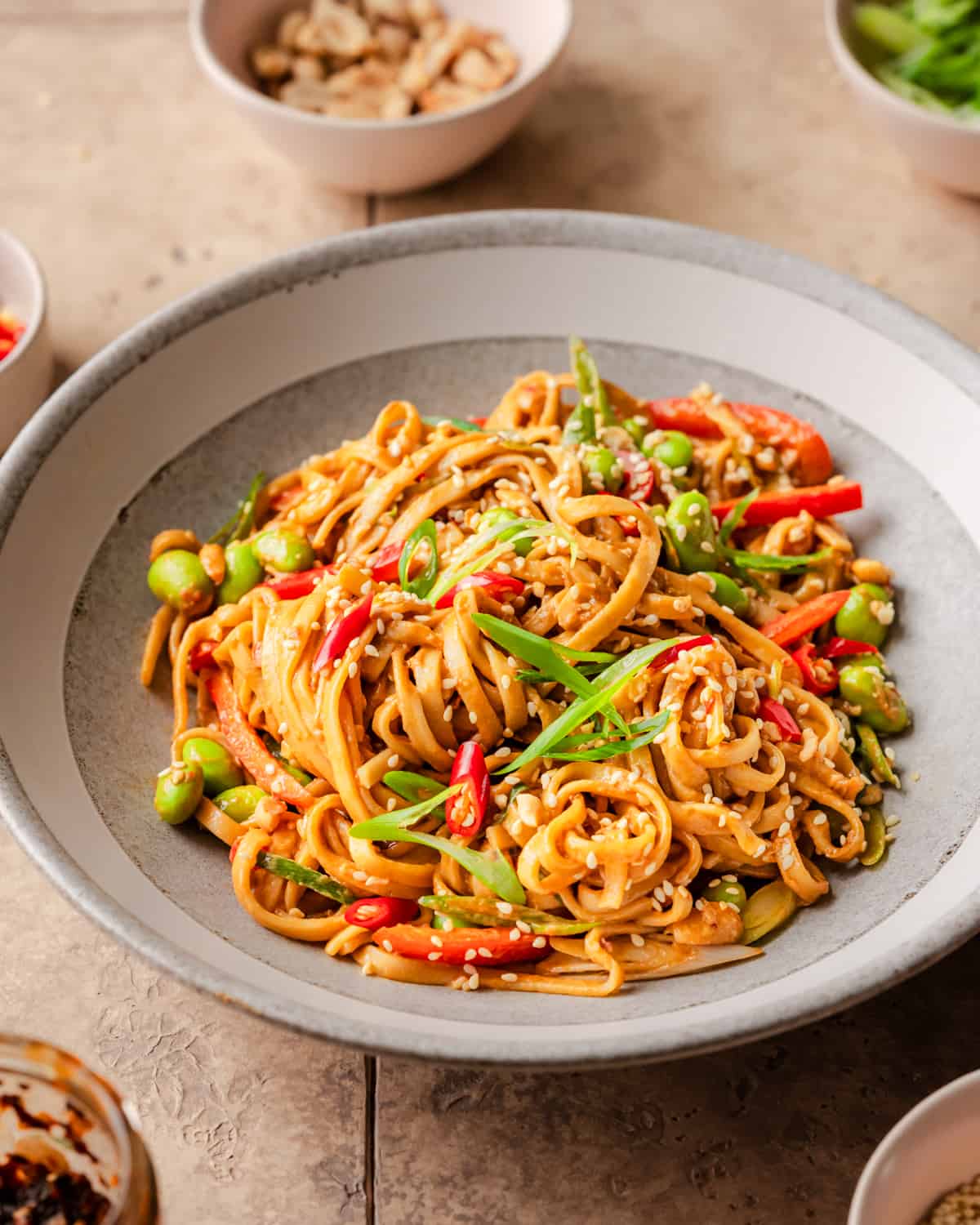Full of creamy, chewy textures and rich, indulgent flavors, you won’t be able to put down your fork (or chopsticks!).
Why this recipe works
Crazy good sauce. The secret to this sauce is the complex flavors of Chinese cuisine mainstays. Chinese sesame paste (affiliate link) makes for a roasty, nutty base that brings soy sauce’s powerful savoriness to life. Rich, toasted sesame oil and funky, complex Chinese black vinegar add bold, layered flavors while chili sauce adds a sassy kick. Big flavor, easy to make. As you cook your noodles, quickly grate some fresh garlic and ginger. Whisk these in with the liquid ingredients for kick and sharpness, and add agave to balance out the acidity. Once everything is ready, mix the sauce and noods, then toss in a few handfuls of edamame, sesame seeds, peanuts, and your favorite raw veggies. Easy to customize. Although Chinese cold sesame noodles are traditionally eaten as a cooling summer side dish, they’re well-rounded enough to be a main dish too. Mix in your favorite veggies for a nutrient-rich meal and top it off with edamame or tofu plus peanuts for more protein. When it comes to garnishes, get creative! Keep it simple with scallions and toasted sesame oil, or fold in chopped cilantro and bean sprouts, plus chili crisp or fresh sliced chilies for heat.
Ingredient notes
Chinese sesame paste
The main event! This rich, thick paste is made from ground-up roasted sesame seeds. It might sound the same as tahini but it’s not. It offers darker, nuttier, stronger flavors and tastes more like peanut butter than tahini. As this blog post from The Woks of Life explains, the sesame seeds in Chinese sesame paste are toasted, while tahini is made from raw sesame seeds. This toasting gives Chinese sesame paste the bold flavors ideal for this flavor-forward dish. Where to buy: You can buy Chinese sesame paste at East Asian grocery stores (I get mine at HMart) or online (affiliate link). Substitutes: While Chinese sesame paste is worth seeking out IMO, I know a lot of folks won’t have access to it. So I recommend using half peanut butter (ideally smooth but crunchy is probably fine; but never sweetened) and half tahini to start (1.5 tbsp each). You can also play around with other ratios (for example, two tablespoons of peanut butter and one tablespoon of tahini).
Soy sauce
This umami-forward pantry staple adds heaps of satisfying savoriness! I use Chinese light soy sauce, which is like saltier grocery-store soy sauce, as well as Chinese dark soy sauce, which is richer and sweeter. The combo kick things up a notch flavor-wise and given how inexpensive they are and how long they last in your fridge, I recommend seeking them at your local East Asian grocery store or online (affiliate link). You might sometimes see dark soy sauce sold as mushroom dark soy sauce. Substitute: You can substitute both with regular grocery store soy sauce, or tamari or gluten-free soy sauce.
Chinese black vinegar
There’s nothing quite like Chinese black vinegar. It adds earthy, tart, and subtly sweet notes plus a big kick of umami and a complex tang. Plus, since it’s fermented, it lasts for ages in the fridge! Use it in my Braised Tofu recipe. Chinkiang vinegar is the most common variety of Chinese black vinegar I’ve seen in the states. Substitutes: Rice vinegar and Shaoxing wine (Chinese cooking wine) work in a pinch. If completely gluten-free, use rice vinegar, as Chinese black vinegar and Shaoxing wine typically have small amounts of grain.
Toasted sesame oil
The rich, nutty flavor and mouthfeel of toasted sesame oil makes this dish absolutely heavenly. Ottogi’s premium roasted sesame oil is my favorite, by far (affiliate link).
Fresh noodles
We tested this recipe with a few different noodles, and while they were tasty with all the noodle varieties we tried, fresh udon noodles were my favorite. They’re chewy, bouncy, and slurpy, and they’re the shining star of my Spicy Chili Garlic Noodles and Gochujang Noodles. I also tried this recipe with fresh white Chinese noodles, which are made from just wheat flour and water (these are the noodles I used in these photos). Skip the yellow noodles such as chow mein or lo noodles, as these typically contain eggs. Where to buy: East Asian markets sell fresh udon noodles and other fresh noodles in the frozen or refrigerated sections or occasionally in shelf-stable, vacuum-sealed packaging. Substitute: This recipe even works well with dried noodles, so feel free to use those. Just be sure to check out the Tips section because the quantity will vary based on the type of noodles used. And skip thin noodles, such as rice vermicelli, as they will wilt under the creamy sauce.
Vegetables
Adding veggies, though optional, transforms this mouthwatering side into a nourishing, filling main. My go-tos are julienned carrots, thinly sliced red bell peppers, or thinly shredded napa cabbage. If you use regular cabbage instead, massage it with a touch of salt and lime juice to soften it and make it less crunchy and cruciferous-y. Or, instead, add finely chopped snap peas or snow peas.
Step-by-step instructions
To make the sesame sauce, stir the ginger, garlic, sesame paste, soy sauces, agave, sesame oil, Chinese black vinegar, and chili-garlic sauce in a bowl. Taste and adjust the flavors as needed. Bring a pot of water to a boil for the noodles. While you wait, prep the mix-in ingredients (e.g., scallions, veggies, peanuts, edamame). Cook the noodles according to the package instructions. Once cooked, reserve some noodle water, then drain the noodles and rinse with cold water. Add the noodles to a large bowl and the sesame sauce to coat. Toss to coat, adding a few splashes of reserved noodle water as needed to coat the noodles and make everything saucy. Add the scallions, vegetables of choice, edamame, sesame seeds, and peanuts. Toss well to combine, garnish as desired, and enjoy.
Tips for making this recipe
Fresh noodles are best, but dried noodles work too. Using fresh udon noodles or fresh Chinese white noodles truly makes this dish sing. I still love this dish with dried noodles, but only use them if you can’t find fresh ones. You’ll need to use more or less noodles based on whether they’re fresh, frozen, or dried and their thickness.Fresh udon noodles (bouncy, thick, and light): use 20 ounces (570g)Frozen udon noodles: use 30 ounces (850g)Other fresh noodles (e.g., fresh Chinese white noodles): use 10 to 12 ounces (280 to 340g). Use the lower amount for saucier noodles. Dried noodles: use 8 ounces (225g) Taste the sauce as you go. The magic of this quick noodle dish is the perfectly balanced sauce. It’s nutty, rich, savory, and a little tangy, spicy, and sweet. You can add more heat, take down the richness, or otherwise change the flavors to your liking if you taste it as you go:
For a sweeter sauce, add more agave (or sugar). For a sharper sauce, add more garlic or ginger. For a tangier sauce, add more vinegar. Add more or less of the other ingredients to suit your taste.
Once your taste buds are jumping for joy, just pour the sauce over your noodles! PS: The sauce will be very bold/concentrated in flavor when you taste it, but it’s going to coat a lot of noodles and will mellow out once it combines with all the other ingredients. Save some noodle water Since sesame paste is quite thick (like tahini), it can leave the noodles a bit dry after the first few minutes. To avoid that, reserve some of the starchy noodle water before draining your noodles. Then use that water to toss with the noodles and sesame sauce (similar to how you add pasta water when combining cooked pasta with sauce). Note: If you are using fresh or frozen udon noodles, you shouldn’t need to add water, as the noodles are quite saucy. Visit your local East Asian market. You’ll likely find Chinese sesame paste, Chinese black vinegar, dark soy sauce, and fresh noodles at your nearest East Asian market. They’re almost always sold at a much cheaper price than you’ll find online. Plus, as you go up and down the aisles, you’ll probably have lots of fun exploring new ingredients and cuisines. Every time I swing by an Asian market, I find something new that I get excited to try. On the hunt for another tasty Asian noodle salad to add to the repertoire? Try my crowd-pleasing Noodle Salad with Rainbow Veggies! Get creative. Add whatever veggies your heart desires, toss in a different protein, or do whatever else you want to make this dish your own. I use edamame as a protein since it’s no-cook and fuss-free, but when you have extra time, Fried Tofu and Baked Tofu are delightful add-ins. Or simply cube up a block of your favorite pre-baked tofu. If you’ve got leftover cilantro, garnish your noodles with it alongside the scallion greens. Another garnish idea: Chinese chili crisp or a drizzle of chili oil really makes this dish shine. For something more out-of-the-box, use zucchini noodles instead of regular noodles or go halfsies (they’re great for summertime!). Of course, I still think udon noodles are the ultimate choice, as their chewy, slurpy, bouncy texture makes this dish an indulgent delight. If you love this Cold Sesame Noodles recipe, please leave a rating and review below :) Your support is always appreciated!
Big Vegan Flavor
Techniques and 150 recipes to master vegan cooking.














